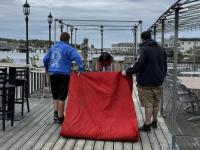Seed starting
“I’m going to start my garden,” Ruth told me. “Do you need any seeds? I have plenty to share.”
She led me to her old-fashioned pantry. On a counter, boxes and small flats were filled with seed packets, filed in alphabetical order.
“Here’s a nice hollyhock,” she said, pulling out a packet. But I was interested in cucumbers and parsley.
Ruth had several kinds of cucumbers and both curly and flat-leaf parsley.
I went home with the Italian, or flat parsley.
But then I found that the seeds were several years old.
Wetting a piece of paper towel, I dotted it with 10 parsley seeds. Then I folded it and put it in a small plastic bag to keep it from drying. I marked it with the name of the plant and the date I’d dampened the seeds. I laid the bag on a low kitchen shelf.
A week later, I opened the bag and looked at the seeds. Nothing much was happening. The following week, each seed had a wisp of green; the parsley was sprouting!
Checking the following week, I found the tiny plants had grown. Carefully, using tweezers, I set each plantlet in a small flat in damp, seed-starter soil. I topped it with a transparent plastic bag.
If those old seeds had failed to show green, I would have used this procedure to discover how viable they were. They would have been easy to calculate. One seed failing: 90 percent good. Seven not responding: 30 percent vigorous enough to grow on.
Why not try this yourself with any leftover seeds?
Event Date
Address
United States





















